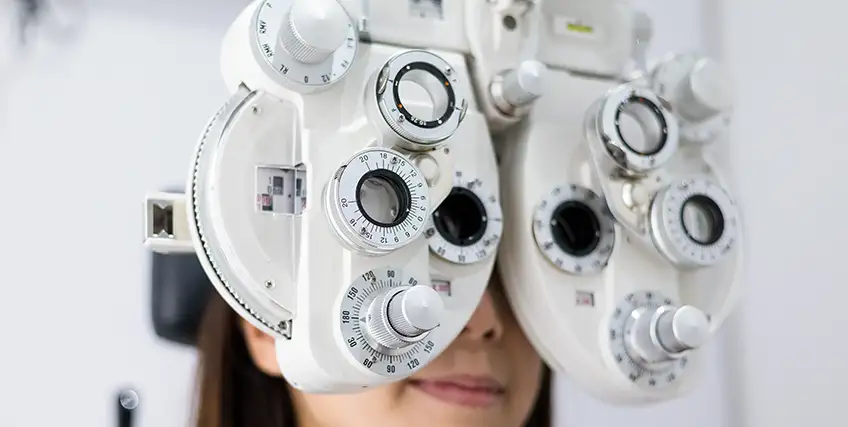How to Finance Your Optometry Practice Equipment, Expansion & More
June 10, 2025 | Last Updated on: June 11, 2025

Best Strategies to Get Optometry Practice Loans
Getting an optometry practice up and running is an exciting milestone in any optometrist’s career. This is a major step toward professional independence, the ability to shape your own patient care philosophy, and the chance to build a thriving, patient-centered business. But like many rewarding ventures, an optometry practice requires a significant financial investment. From leasing or renovating office space and purchasing diagnostic equipment to hiring staff and managing daily operations, the costs can quickly climb.
Whether you’re launching your first practice, buying into an existing partnership, or expanding your optometrist clinic, securing the right optometry practice loan can be the key to turning your vision into reality. These optometry practice loans are tailored to meet the needs of eye care professionals—but they can be more complicated than traditional business financing.
Financial lenders often consider a variety of factors, including your credit, professional experience, business plan, and expected cash flow. The financing process can be daunting, especially when you’re trying to focus on creating a patient-first environment.
This guide outlines the best strategies to help you navigate the process of securing optometry practice loans. Whether you're a recent graduate or a seasoned optometrist, learn valuable insights to help you prepare, apply, and position your optometry practice for ongoing success.
1. What Are Your Financing Needs?
You need to understand the specific needs of your practice before you apply for any loan. Defining your needs involves creating a detailed financial plan that outlines exactly how much you need and what it will be used for. Here are some uses for optometry practice loans:
- Acquiring a practice
- Starting a new practice from scratch
- Buying medical or diagnostic equipment
- Renovating office space
- Hiring staff or expanding services
- Working capital to cover operational costs
Strategy Tip: Break down your costs into specific categories (e.g., equipment: $100,000; working capital: $50,000; renovations: $80,000) so you can justify the loan amount during your application.
2. What is Your Comprehensive Business Plan?
Financial lends will likely need assurance that your optometry practice can become profitable and sustainable. A strong optometry practice loan business plan will increase your chances of getting approved and can also help secure better loan terms.
Key components to include:
- Executive Summary: A definition of your goals, mission, and vision to include for your optometry practice loan.
- Market Analysis: Details into local competition, target demographics, and patient demand.
- Marketing Strategy: Plans for attracting and retaining patients.
- Operational Plan: Staffing, office hours, equipment, and services.
- Financial Projections: Income statement, balance sheet, cash flow, and breakeven analysis.
- Loan Request: Specific amount, use of funds, and expected ROI.
Strategy Tip: Include a SWOT analysis (Strengths, Weaknesses, Opportunities, Threats) to demonstrate awareness of business challenges and mitigation strategies for the optometry practice loan.
3. Know the Types of Optometry Practice Loans
There are several optometry practice loan options that are tailored specifically for this industry, including:
a. SBA Loans (Small Business Administration)
SBA loans (especially the SBA 7(a) loan) are popular among healthcare providers because of their favorable terms—low interest rates and longer repayment periods for qualified applicants. However, the application process can be lengthy and requires strong documentation.
Pros:
- Competitive interest rates
- Long repayment terms (up to 25 years for real estate)
- Low down payments
Cons:
- Lengthy approval time
- Extensive documentation required
b. Bank Loans
Traditional bank loans are an option for those with strong credit and existing banking relationships. Certain financial institutions offer specifice medical or optometry practice loans and can tailor them accordingly.
Pros:
- Personalized service
- Competitive rates with good credit
Cons:
- High credit standards
- Strict qualification criteria
c. Optometry Equipment Financing
Optometry equipment financing is an option for those seeking loans for this need specifically. If you’re looking to purchase diagnostic or treatment equipment, optometry equipment financing may be ideal. It easier to qualify for this type of financing because the equipment acts as collateral.
Pros:
- Possible fast approval
- Equipment serves as collateral
Cons:
- Funds limited to equipment use only
- Higher interest rates than SBA loans
d. Practice Acquisition Loans
If you're buying an existing practice, these optometry practice loans are structured to cover the purchase price and transition costs. Many lenders have specific acquisition programs for optometry practice loans.
Pros:
- Designed for healthcare transitions
- May include working capital
Cons:
- May require significant down payment
- Dependent on practice valuation
e. Alternative Lenders
Alternative lenders are considered online and informal loans that offer fast funding, though usually with higher interest rates. These types of loans may be suitable for urgent needs or when traditional financing isn’t available as an option for your optometry practice loan.
Pros:
- Possible fast approval and funding
- Less stringent qualifications
Cons:
- Higher interest rates
- Shorter repayment terms
4. How is Your Credit Profile?
What does your credit profile bring to the lending table? Lenders will take a deep look at your personal and business credit to understand your level of credit scoring on both fronts. A strong credit score significantly boosts your chances of approval and favorable terms.
Actionable steps:
- Request a copy of your credit report
- Correct any errors or discrepancies
- Pay down existing debt
- Avoid taking on new debt before applying
Strategy Tip: Lenders also look at your debt service coverage ratio (DSCR)—your ability to repay debt with current income. Aim for a DSCR of 1.25 or higher.
5. Do You Have Strong Financial Documentation?
You’ll need to present a comprehensive package of financial documents in order to qualify for an optometry practice loan. If you have missing or incomplete paperwork, you can delay or derail your application.
Typical documents include:
- Tax returns (personal and business) – past 2–3 years
- Personal financial statements
- Profit and loss statements
- Balance sheets
- Cash flow projections
- Business licenses and incorporation papers
- Loan history (if applicable)
- Resume and credentials (for new practices)
Strategy Tip: An accountant with experience in healthcare practices is essential to prepare and review your financials before submission.
6. Choose a Lender Experienced in Healthcare or Optometry
The unique business model of optometry requires specific lending partners who understand the nuances of the practice. Partner with a lender who specializes in healthcare or optometry practice loans to ensure they appreciate industry nuances, which include billing cycles, insurance reimbursements, and patient flow.
Specialized lenders may offer:
- Customized repayment schedules (e.g., deferred payments for startups)
- Higher approval rates for optometrists
- Advice on practice management and operations
Strategy Tip: Interview lenders the same way you would hire a key employee. Ask about their experience with optometry practice loans and how many practices they've funded.
7. Can You Negotiate Terms That Suit Your Practice?
The initial optometry practice loan offer without review is not your best option. In order to get the best terms for your needs, make sure to evaluate and negotiate the following elements:
- Interest Rate: Fixed or variable? How does it compare to industry averages?
- Term Length: Match repayment terms to the expected life of the asset.
- Repayment Schedule: Are there prepayment penalties? Can payments be deferred?
- Collateral Requirements: What assets must you pledge?
- Personal Guarantees: Are you personally liable if the business fails?
Strategy Tip: Ideally, find lenders who offer graduated payment plans. The is entails payments that start low and increase as your revenue grows so that you can successfully manage your payments.
8. What About Partnering with a Loan Broker?
To better understand which lender or optometry practice loan product is best, a loan broker can help. Loan brokers have relationships with various lenders and can match you with those most likely to approve your loan.
Advantages of using a broker:
- Saves time researching
- May improve approval odds
- Helps negotiate better terms
Disadvantages:
- Fees or commissions may be taken
- Quality varies—not necessarily a specification in healthcare
9. Do You Have Additional Funding Sources?
In addition to traditional optometry practice loans, here are other financial tools to support your practice:
- Lines of Credit: Useful for short-term cash flow needs
- Business Credit Cards: Great for managing smaller expenses and earning rewards
- Angel Investors or Partnerships: Rare in optometry, but possible for larger expansions
- Vendor Financing: Some equipment suppliers offer in-house financing
Strategy Tip: Use short-term optometry financing (like lines of credit) for operational needs and long-term loans for capital expenditures.
10. What is Your Plan for Post-Funding Success?
For you to keep and maintain optometry financing successfully, make sure you have a plan for what comes next. Here are some suggestions for how to properly manage the funds wisely:
- Stick to the intended use of the loan
- Track every expense and maintain financial transparency
- Monitor your debt obligations and make timely payments
- Reinvest profits into marketing, staff development, and technology
Strategy Tip: Evaluate financial health and adjust your strategy as needed by setting quarterly reviews with a financial advisor or accountant.
Final Thoughts on Optometry Practice Loans
Securing an optometry practice loan is a significant step toward launching, acquiring, or expanding your practice. The loan process can be complex, but with strategic planning, proper documentation, and a clear understanding of your financing options, you can increase your chances of approval and secure the best possible terms.
Partner with experienced lenders, create a solid business plan, and maintain strong financials. You will position your practice for sustainable growth and long-term success. Whether you’re just starting out or scaling up, financing for buying your optometry practice can be the fuel that powers your professional vision—literally and figuratively.
FAQs About Optometry Practice Loans
Are SBA loans a good option for optometry practice loans?
SBA loans (especially the SBA 7(a) loan) are often used among healthcare providers because of their favorable terms—low interest rates and longer repayment periods.
What are loan brokers for optometry practice loans?
Loan brokers are professionals who have relationships with various lenders and can match you with those who are most likely to approve your loan.
What is a good strategy to look for in considering optometry practice loans?
One pro tip is to look for lenders who offer graduated payment plans, where payments start low and increase as your revenue grows.
When are alternative lenders a promising option for optometry practice financing?
Alternative lenders may be suitable for urgent needs or when traditional financing isn’t available as an option for your optometry practice loan.
What is one strategy to best manage loans for opening an optometry practice?
After loan approval, be sure to set quarterly reviews with a financial advisor or accountant to evaluate financial health and adjust your strategy as needed.




